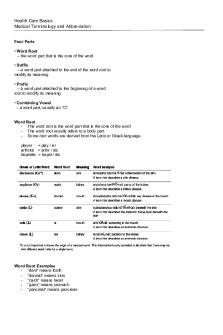4 Terms PDF

| Title | 4 Terms |
|---|---|
| Author | Kryv Er |
| Course | Age of Dinosaurs |
| Institution | University of Texas at Austin |
| Pages | 2 |
| File Size | 39.9 KB |
| File Type | |
| Total Downloads | 60 |
| Total Views | 135 |
Summary
Important terms...
Description
Terms: Homology vs homoplasy: - Homology: similarity between taxa resulting from a common ancestor, stems from divergent evolution. Examples: vertebrate limbs, which emerged from a common ancestor but have different functions. Homoplasy: similar characteristics in different organisms that arose separately (Seeley). Stems from convergent evolution. E.g. wings of birds/bats/insects Synapomorphy vs Autopomorphy vs Plesiomorphy vs Apomorphy: - Synapomorphy: shared, derived character. - Autopomorphy: a derived (new) character that´s present in only one taxon on your tree - Plesiomorphy: a primitive, ancestral trait - Apomorphy: a novel evolutionary trait unique to a particular species and all its descendants, e.g. feathers to birds; defines all members of Aves Theory vs law vs hypothesis: - Theory: a group of propositions formulated to explain a group of facts, repeatedly confirmed through experiments - Hypothesis: a premise/assertion subject to testing/falsification; only after many failures to falsify a hypothesis does it become a theory - Law: observed phenomenon which always applies under the same conditions, but doesn´t necessarily explain why the phenomenon occurs Darwinian vs Larmackian evolution: Monophyly vs Paraphyly vs Polyphyly: - Monophyly: a group that includes an ancestor and all its descendants - Paraphyly: a group that consists of an ancestor and only some (but not all) of its descendants - Polyphyly: a group that doesn´t share a recent common ancestor; grouped on similarities unrelated to ancestry, like a streamlined body Cladistics vs Phylogenetic Systematics vs Linnaean Systematics: - Cladistics: shows relations among organisms - Phylogenetic systematics: the field within biology that reconstructs evolutionary history - Linnaean systematics: organisms grouped according to shared characteristics, not evolution; fixed categories, with kingdom at the top and subspecies at the bottom Extinction vs Mass extinction: Ontogeny: origination and development of an organism; feathers form in ontogeny. Recapitulation: repetition of ancestral changes in an organism´s ontogeny; means that in the development of an animal throughout its ontogeny, it goes through stages resembling the stages in the evolution of its ancestors.
Atavism: when an ancestral trait appears, after having been lost through evolutionary changes (e.g. tails in humans) Age of fishes (Paleozoic) vs Age of reptiles (Mesozoic) vs Age of mammals (Cenozoic = tertiary + quarternary)...
Similar Free PDFs

4 Terms
- 2 Pages

Chapter 4 key terms
- 2 Pages

Biology UNIT 4 Key Terms
- 3 Pages

Chapter 4 Terms and Definitions
- 5 Pages

Exam 4 Review and Terms
- 4 Pages

Terms
- 8 Pages

Terms
- 12 Pages

Essay-Terms - Innominate Terms
- 4 Pages

MEE2 Unit 4 Terms and Practice
- 3 Pages

Key Terms
- 3 Pages

Technical terms
- 2 Pages

SLA Terms
- 5 Pages

Quizlet of course terms
- 8 Pages

Medical Terms Master List
- 5 Pages
Popular Institutions
- Tinajero National High School - Annex
- Politeknik Caltex Riau
- Yokohama City University
- SGT University
- University of Al-Qadisiyah
- Divine Word College of Vigan
- Techniek College Rotterdam
- Universidade de Santiago
- Universiti Teknologi MARA Cawangan Johor Kampus Pasir Gudang
- Poltekkes Kemenkes Yogyakarta
- Baguio City National High School
- Colegio san marcos
- preparatoria uno
- Centro de Bachillerato Tecnológico Industrial y de Servicios No. 107
- Dalian Maritime University
- Quang Trung Secondary School
- Colegio Tecnológico en Informática
- Corporación Regional de Educación Superior
- Grupo CEDVA
- Dar Al Uloom University
- Centro de Estudios Preuniversitarios de la Universidad Nacional de Ingeniería
- 上智大学
- Aakash International School, Nuna Majara
- San Felipe Neri Catholic School
- Kang Chiao International School - New Taipei City
- Misamis Occidental National High School
- Institución Educativa Escuela Normal Juan Ladrilleros
- Kolehiyo ng Pantukan
- Batanes State College
- Instituto Continental
- Sekolah Menengah Kejuruan Kesehatan Kaltara (Tarakan)
- Colegio de La Inmaculada Concepcion - Cebu

